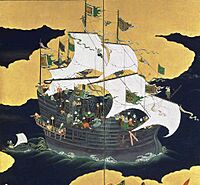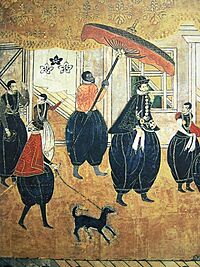João Rodrigues Tçuzu facts for kids
Quick facts for kids
João Rodrigues
|
|
|---|---|
| Born | 1561 or 1562 Sernancelhe, Portugal
|
| Died | 1633 or 1634 Macao, Portuguese Empire (China)
|
| Occupation | soldier, interpreter, priest |
| Known for | early linguistic works on Japanese; introducing western science and culture to Korea |
| João Rodrigues | |||||||||||||
|---|---|---|---|---|---|---|---|---|---|---|---|---|---|
| Chinese name | |||||||||||||
| Traditional Chinese | 陸若漢 | ||||||||||||
| Simplified Chinese | 陆若汉 | ||||||||||||
|
|||||||||||||
| Korean name | |||||||||||||
| Hangul | 육약한 | ||||||||||||
|
|||||||||||||
João Rodrigues (born 1561 or 1562, died 1633 or 1634) was an important Portuguese explorer, soldier, and Jesuit priest. He was also a skilled interpreter and scholar. He spent many years in Japan and China.
Rodrigues is best known for his work on the Japanese language. His book, The Art of the Japanese Language, was one of the first detailed grammars of Japanese. For a long time, people also thought he helped create the first Japanese–Portuguese dictionary. However, this was later found to be incorrect.
Contents
Who was João Rodrigues?
João Rodrigues was often called Tçuzu. This name came from the Japanese word Tsūji, which means "the Interpreter". This helped tell him apart from another person named João Rodrigues who was also a Jesuit missionary.
In Japan and China, Rodrigues used the Chinese name Lu Ruohan. This was a way to fit his name into the Chinese style. In modern Korean, his name is written as Yuk Yakhan.
João Rodrigues's Adventures
Early Life in Japan
João Rodrigues was born in Sernancelhe, Portugal, around 1561 or 1562. When he was a teenager, he sailed to Asia and arrived in Japan by 1577. He joined the Jesuit religious group in 1580, when he was about 19 years old. At that time, there were many Christians in Japan.
Rodrigues was very good at learning languages. He quickly became fluent in Japanese. He could also understand Chinese writing. This skill helped him translate important documents. He even knew some Italian and an Indian language.
He became an interpreter for important Jesuit leaders. He helped them speak with powerful Japanese leaders like Toyotomi Hideyoshi. Hideyoshi was so impressed that he hired Rodrigues as his personal interpreter for a while.
In 1594, Rodrigues became a priest in Macao. He then returned to Japan. He remained influential under the new shogun, Tokugawa Ieyasu. Rodrigues worked to protect Jesuit missions and Japanese Christians. However, things changed. After some conflicts involving Portuguese traders in Macao, Tokugawa Ieyasu decided to limit Portuguese trade. In 1614, Rodrigues was forced to leave Japan after living there for over 30 years.
Life in China
After leaving Japan, Rodrigues went back to Macao. He then joined the Jesuit mission in China. He traveled around China, looking for old Christian sites. He also took part in a debate about how Christian traditions should fit with Chinese customs.
In 1623, Rodrigues went to Beijing as an interpreter. He was part of a group of Portuguese who were showing off European cannons. These cannons were called hongyipao. During one demonstration, a cannon exploded. This accident caused Rodrigues and his group to return to Macao.
In 1629, Rodrigues, who was 68 years old, returned to Beijing. He was an interpreter for another group bringing cannons to the Chinese capital. They trained Chinese troops in how to use these modern cannons.
Meeting the Koreans
In 1631, Rodrigues met Jeong Duwon. Jeong Duwon was a Korean official visiting Beijing. Rodrigues showed him the Jesuits' work in astronomy and other sciences. He even gave Jeong Duwon his own telescope. Jeong Duwon was very impressed with the telescope's use in warfare. Rodrigues also gave him a small fieldgun and books about European customs.
Rodrigues also spoke with Jeong Duwon's assistants. One assistant, Yi Yeonghu, was curious if China was truly the center of the Earth. Rodrigues explained that since the Earth is a sphere, every country can see itself as the center.
Escape from Dengzhou
In 1632, there was a rebellion in the city of Dengzhou. Rodrigues was there, helping to train soldiers. When the city fell, Rodrigues escaped by jumping from the high city wall into the sea. He then made his way back to Beijing. He was praised for his service.
Rodrigues returned to Macao in 1633. He died there sometime before March 1634. His remains were later buried inside the São Paulo church in Macao.
João Rodrigues's Writings
The Art of the Japanese Language
Rodrigues wrote The Art of the Japanese Language. It was published in Japan between 1604 and 1608. This book was very important. It explained Japanese grammar and vocabulary. It also included details about Japan's rulers, money, and measurements. It was one of the first printed Japanese grammar books.
The Short Art of the Japanese Language
In 1620, Rodrigues published a shorter version called The Short Art of the Japanese Language. This book didn't just shorten the first one. It explained Japanese grammar in a new, clearer way.
History of the Japanese Church
Rodrigues also worked on a large book called History of the Japanese Church. He wanted to finish earlier works by other Jesuits. This book described Japanese history and culture. It talked about the Japanese language, Chinese characters, and writing styles.
Rodrigues wrote about the expansion of Portuguese influence in Japan. He also described the arrival of the first Englishman, William Adams. He wrote about the rise of the Tokugawa Shogunate. His writings show that he was very open-minded about Japanese culture. He even praised the holiness of Buddhist monks.
Other Writings
Rodrigues also wrote about Chinese Buddhist groups. He wrote about the geography of China. He also wrote a letter to Jeong Duwon about Western astronomy. In China, he described an ancient stone tablet found in Xi'an. He also wrote a piece praising the bravery of Captain Teixeira during the Dengzhou siege.
On the Japanese-Portuguese Dictionary
For a long time, people believed that João Rodrigues was the main person who put together the first Japanese–Portuguese dictionary. This dictionary was published in 1603. However, it was later found that he was not the main compiler. His exact role in creating the dictionary is still debated.
João Rodrigues's Legacy
The character of Martin Alvito in the famous book Shōgun by James Clavell is loosely based on João Rodrigues. The main character of the book is based on William Adams.



